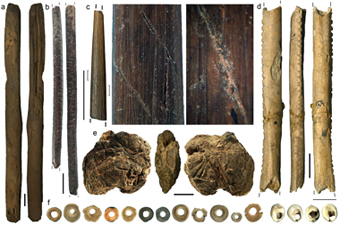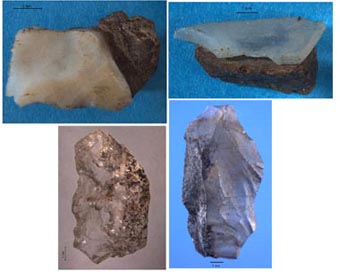Fuente: CNRS - All themes
Expuesto el: jueves, 26 de julio de 2012 22:00
Autor: CNRS - All themes
Asunto: The appearance of the first cultures of modern hunter-gatherers of South Africa pushed back by 24,000 years
| Border Cave, situated in KwaZulu-Natal in the east of South Africa, is an archeological site that has been undergoing excavation since the 1970s. It stands out on account of the exceptional conservation of organic matter. Initial analyses showed that very complex objects and techniques were already in existence more than 30,000 years ago. However, these conclusions did not convince the scientific community. Now, new datings and analyses performed by the researchers demonstrate that around 44,000 years ago a profound technological transition began, namely the passage from the Middle Stone Age to the Later Stone Age, which took place between 44,000 and 42,000 years ago. The archeological material found in several stratigraphic levels shows that this transition stemmed from a process that arose within the community that inhabited Border Cave and was not due to the sudden arrival of other human groups. The objects found in this cave bear witness to the appearance of new behavioral patterns, similar to those of present day hunter-gatherers. Among the main innovations that characterize this technological transition, there is the use of small sized bows and arrows with bone tips coated with a ricinoleic acid based poison(1). Previously, the inhabitants of Border Cave used larger stone tips, which were probably attached to spears. Another notable innovation that appeared at this time was the production of a pitch produced from the bark of Podocarpus, a conifer that is very widespread in South Africa, used to fix arrow heads. This demonstrates an extremely sophisticated know-how. A piece of beeswax, mixed with toxic resin of Euphorbia(2) and probably egg, was found wrapped in a cord made of tree bark fibers. This find, a Stone Age kit for attaching arrow heads or other tools and directly dated at 40,000 years, represents the oldest known use of beeswax. The innovations concerning jewelry and decorated objects are also very striking: the transition to the Later Stone Age was accompanied by the use of ostrich eggs to produce beads. The similarity between these objects dated at more than 40,000 years ago and those still used today by the San, also known as Bushmen, the first people of southern Africa, is clear. The beating sticks weighted with perforated stones found in Border Cave are like those still made today. Like the present day San, the inhabitants of the cave fashioned notches on bones to use as counting or notation tools. The use of light bows and poisoned arrow heads is also a striking point of similarity. This shows that the lifestyle of present day hunter-gatherers of South Africa dates back to at least 44,000 years, and not 20,000 years ago as was previously thought.
© Errico/Backwell Objects discovered in the archeological layers of Border Cave, South Africa. a: wooden beating stick, b: wooden stick decorated with notches and bearing at its end residues of ricinoleic acid, c: bone point decorated with a spiral engraving filled with orange pigment, d: baboon fibula with one edge covered with notches engraved by four different lithic cutting edges, e: object constituted of beeswax and plant resin, f: ostrich egg and shell beads. Scale = 1 cm. - Visual available on request: phototheque@cnrs-bellevue.fr
© Villa et al., PNAS 2012 Border Cave. Top: two chalcedony microliths less than 1 cm, stuck to a piece of pitch. Bottom: two microliths with probable traces of pitch on their sides, which indicate a lateral fitting onto a handle. Modified after Villa et al. in PNAS 2012. Visual available on request: phototheque@cnrs-bellevue.fr Notes: (1) A hydroxylated omega-9 fatty acid. References: Early evidence of San material culture represented by organic artifacts from Border Cave, South Africa. Francesco d'Errico, Lucinda Backwell, Paola Villa, Ilaria Degano, Jeannette J. Lucejkog, Marion K. Bamford, Thomas F.G. Higham, Maria Perla Colombini, Peter B. Beaumont. PNAS, July 2012. Border Cave and the beginning of the Later Stone Age in South Africa. Paola Villa, Sylvain Soriano, Tsenka Tsanova, Ilaria Degano, Thomas Higham, Francesco d'Errico, Lucinda Backwell , Jeannette J. Lucejko, Maria Perla Colombini, Peter Beaumont, PNAS, July 2012.
|


